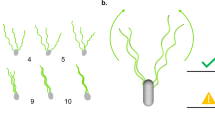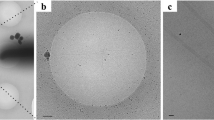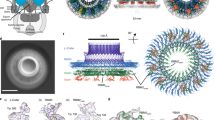Abstract
Large protein complexes assemble spontaneously, yet their subunits do not prematurely form unwanted aggregates. This paradox is epitomized in the bacterial flagellar motor, a sophisticated rotary motor and sensory switch consisting of hundreds of subunits. Here we demonstrate that Escherichia coli FliG, one of the earliest-assembling flagellar motor proteins, forms ordered ring structures via domain-swap polymerization, which in other proteins has been associated with uncontrolled and deleterious protein aggregation. Solution structural data, in combination with in vivo biochemical cross-linking experiments and evolutionary covariance analysis, revealed that FliG exists predominantly as a monomer in solution but only as domain-swapped polymers in assembled flagellar motors. We propose a general structural and thermodynamic model for self-assembly, in which a structural template controls assembly and shapes polymer formation into rings.
This is a preview of subscription content, access via your institution
Access options
Subscribe to this journal
Receive 12 print issues and online access
$189.00 per year
only $15.75 per issue
Buy this article
- Purchase on Springer Link
- Instant access to full article PDF
Prices may be subject to local taxes which are calculated during checkout




Similar content being viewed by others
Accession codes
References
Sowa, Y. & Berry, R.M. Bacterial flagellar motor. Q. Rev. Biophys. 41, 103–132 (2008).
Macnab, R.M. How bacteria assemble flagella. Annu. Rev. Microbiol. 57, 77–100 (2003).
Erhardt, M., Namba, K. & Hughes, K.T. Bacterial nanomachines: the flagellum and type III injectisome. Cold Spring Harb. Perspect. Biol. 2, a000299 (2010).
Lele, P.P., Hosu, B.G. & Berg, H.C. Dynamics of mechanosensing in the bacterial flagellar motor. Proc. Natl. Acad. Sci. USA 110, 11839–11844 (2013).
Huber, A.H., Nelson, W.J. & Weis, W.I. Three-dimensional structure of the armadillo repeat region of β-catenin. Cell 90, 871–882 (1997).
Tewari, R., Bailes, E., Bunting, K.A. & Coates, J.C. Armadillo-repeat protein functions: questions for little creatures. Trends Cell Biol. 20, 470–481 (2010).
Lee, L.K., Ginsburg, M.A., Crovace, C., Donohoe, M. & Stock, D. Structure of the torque ring of the flagellar motor and the molecular basis for rotational switching. Nature 466, 996–1000 (2010).
Sircar, R. et al. Assembly states of FliM and FliG within the flagellar switch complex. J. Mol. Biol. 427, 867–886 (2015).
Minamino, T. et al. Structural insight into the rotational switching mechanism of the bacterial flagellar motor. PLoS Biol. 9, e1000616 (2011).
Vartanian, A.S., Paz, A., Fortgang, E.A., Abramson, J. & Dahlquist, F.W. Structure of flagellar motor proteins in complex allows for insights into motor structure and switching. J. Biol. Chem. 287, 35779–35783 (2012).
Delalez, N.J. et al. Signal-dependent turnover of the bacterial flagellar switch protein FliM. Proc. Natl. Acad. Sci. USA 107, 11347–11351 (2010).
Paul, K., Brunstetter, D., Titen, S. & Blair, D.F. A molecular mechanism of direction switching in the flagellar motor of Escherichia coli . Proc. Natl. Acad. Sci. USA 108, 17171–17176 (2011).
Stock, D., Namba, K. & Lee, L.K. Nanorotors and self-assembling macromolecular machines: the torque ring of the bacterial flagellar motor. Curr. Opin. Biotechnol. 23, 545–554 (2012).
Sharpe, J.C. & London, E. Diphtheria toxin forms pores of different sizes depending on its concentration in membranes: probable relationship to oligomerization. J. Membr. Biol. 171, 209–221 (1999).
Sambashivan, S., Liu, Y., Sawaya, M.R., Gingery, M. & Eisenberg, D. Amyloid-like fibrils of ribonuclease A with three-dimensional domain-swapped and native-like structure. Nature 437, 266–269 (2005).
Yamasaki, M., Li, W., Johnson, D.J.D. & Huntington, J.A. Crystal structure of a stable dimer reveals the molecular basis of serpin polymerization. Nature 455, 1255–1258 (2008).
Hirota, S. et al. Cytochrome c polymerization by successive domain swapping at the C-terminal helix. Proc. Natl. Acad. Sci. USA 107, 12854–12859 (2010).
Das, P., King, J.A. & Zhou, R. Aggregation of γ-crystallins associated with human cataracts via domain swapping at the C-terminal β-strands. Proc. Natl. Acad. Sci. USA 108, 10514–10519 (2011).
Hopf, T.A. et al. Three-dimensional structures of membrane proteins from genomic sequencing. Cell 149, 1607–1621 (2012).
Hopf, T.A. et al. Sequence co-evolution gives 3D contacts and structures of protein complexes. eLife 3, e03430 (2014).
Neher, E. How frequent are correlated changes in families of protein sequences? Proc. Natl. Acad. Sci. USA 91, 98–102 (1994).
Lam, K.-H. et al. Multiple conformations of the FliG C-terminal domain provide insight into flagellar motor switching. Structure 20, 315–325 (2012).
Brown, P.N., Hill, C.P. & Blair, D.F. Crystal structure of the middle and C-terminal domains of the flagellar rotor protein FliG. EMBO J. 21, 3225–3234 (2002).
David, G. & Pérez, J. Combined sampler robot and high-performance liquid chromatography: a fully automated system for biological small-angle X-ray scattering experiments at the Synchrotron SOLEIL SWING beamline. J. Appl. Crystallogr. 42, 892–900 (2009).
Hynson, R.M.G., Duff, A.P., Kirby, N., Mudie, S. & Lee, L.K. Differential ultracentrifugation coupled to small-angle X-ray scattering on macromolecular complexes. J. Appl. Crystallogr. 48, 769–775 (2015).
Franke, D., Jeffries, C.M. & Svergun, D.I. Correlation Map, a goodness-of-fit test for one-dimensional X-ray scattering spectra. Nat. Methods 12, 419–422 (2015).
Lam, K.-H. et al. Structural basis of FliG-FliM interaction in Helicobacter pylori . Mol. Microbiol. 88, 798–812 (2013).
DeRosier, D. Bacterial flagellum: visualizing the complete machine in situ . Curr. Biol. 16, R928–R930 (2006).
Paul, K., Gonzalez-Bonet, G., Bilwes, A.M., Crane, B.R. & Blair, D. Architecture of the flagellar rotor. EMBO J. 30, 2962–2971 (2011).
Richey, B. et al. Variability of the intracellular ionic environment of Escherichia coli. Differences between in vitro and in vivo effects of ion concentrations on protein-DNA interactions and gene expression. J. Biol. Chem. 262, 7157–7164 (1987).
Zimmerman, S.B. & Trach, S.O. Estimation of macromolecule concentrations and excluded volume effects for the cytoplasm of Escherichia coli . J. Mol. Biol. 222, 599–620 (1991).
Kuznetsova, I.M., Turoverov, K.K. & Uversky, V.N. What macromolecular crowding can do to a protein. Int. J. Mol. Sci. 15, 23090–23140 (2014).
Rief, M., Gautel, M., Oesterhelt, F., Fernandez, J.M. & Gaub, H.E. Reversible unfolding of individual titin immunoglobulin domains by AFM. Science 276, 1109–1112 (1997).
Dunn, K.E. et al. Guiding the folding pathway of DNA origami. Nature 525, 82–86 (2015).
Thomas, D.R., Francis, N.R., Xu, C. & DeRosier, D.J. The three-dimensional structure of the flagellar rotor from a clockwise-locked mutant of Salmonella enterica serovar Typhimurium. J. Bacteriol. 188, 7039–7048 (2006).
Thomas, D., Morgan, D.G. & DeRosier, D.J. Structures of bacterial flagellar motors from two FliF-FliG gene fusion mutants. J. Bacteriol. 183, 6404–6412 (2001).
Brown, P.N., Terrazas, M., Paul, K. & Blair, D.F. Mutational analysis of the flagellar protein FliG: sites of interaction with FliM and implications for organization of the switch complex. J. Bacteriol. 189, 305–312 (2007).
Marykwas, D.L. & Berg, H.C. A mutational analysis of the interaction between FliG and FliM, two components of the flagellar motor of Escherichia coli . J. Bacteriol. 178, 1289–1294 (1996).
Dyer, C.M., Vartanian, A.S., Zhou, H. & Dahlquist, F.W. A molecular mechanism of bacterial flagellar motor switching. J. Mol. Biol. 388, 71–84 (2009).
Shameer, K., Pugalenthi, G., Kandaswamy, K.K. & Sowdhamini, R. 3dswap-pred: prediction of 3D domain swapping from protein sequence using Random Forest approach. Protein Pept. Lett. 18, 1010–1020 (2011).
Bennett, M.J., Sawaya, M.R. & Eisenberg, D. Deposition diseases and 3D domain swapping. Structure 14, 811–824 (2006).
Marks, D.S. et al. Protein 3D structure computed from evolutionary sequence variation. PLoS One 6, e28766 (2011).
Johnson, L.S., Eddy, S.R. & Portugaly, E. Hidden Markov model speed heuristic and iterative HMM search procedure. BMC Bioinformatics 11, 431 (2010).
Konarev, P.V., Petoukhov, M.V., Volkov, V.V. & Svergun, D.I. ATSAS2.1, a program package for small-angle scattering data analysis. J. Appl. Crystallogr. 39, 277–286 (2006).
Kozin, M.B. & Svergun, D.I. Automated matching of high-and low-resolution structural models. J. Appl. Crystallogr. 34, 33–41 (2001).
Wriggers, W. Using Situs for the integration of multi-resolution structures. Biophys. Rev. 2, 21–27 (2010).
Pettersen, E.F. et al. UCSF Chimera: a visualization system for exploratory research and analysis. J. Comput. Chem. 25, 1605–1612 (2004).
Guzman, L.M., Belin, D., Carson, M.J. & Beckwith, J. Tight regulation, modulation, and high-level expression by vectors containing the arabinose PBAD promoter. J. Bacteriol. 177, 4121–4130 (1995).
Papworth, C., Bauer, J.C., Braman, J. & Wright, D.A. Site-directed mutagenesis in one day with >80% efficiency. Strategies 9, 3–4 (1996).
Parkinson, J.S. Complementation analysis and deletion mapping of Escherichia coli mutants defective in chemotaxis. J. Bacteriol. 135, 45–53 (1978).
Morimoto, Y.V., Nakamura, S., Kami-ike, N., Namba, K. & Minamino, T. Charged residues in the cytoplasmic loop of MotA are required for stator assembly into the bacterial flagellar motor. Mol. Microbiol. 78, 1117–1129 (2010).
Acknowledgements
SAXS data were collected on the SAXS/WAXS beamline at the Australian Synchrotron, Victoria, Australia. This work was supported by the Australian Research Council (grant DP130102219 to L.K.L.) and the Human Frontiers Science Program (grant RGP0030/2013 to L.K.L., K.N., R.M.B. and A.J.T.). L.K.L. is supported by an Australian Research Council Discovery Early Career Research Award (grant DE140100262).
Author information
Authors and Affiliations
Contributions
M.A.B.B. analyzed SAXS data, performed covariance and thermodynamic analysis, conceived experiments and wrote the manuscript. R.M.G.H. collected SAXS data and performed cross-linking assays. L.A.G. expressed and purified protein and collected SAXS data. N.S.M. performed cross-linking assays and in vivo functional assays. C.W.L. expressed and purified protein and collected SAXS data. A.A.R. expressed and purified protein. A.P.D. collected and analyzed SAXS data. A.E.W. and C.M.J. analyzed SAXS data. N.J.D. and J.P.A. constructed cell lines for this study. Y.V.M. performed fluorescence imaging experiments. D.S. conceived experiments and contributed to cross-linking experiments. A.J.T. and R.M.B. performed thermodynamic analysis, conceived experiments and wrote the manuscript. K.N. performed fluorescence imaging experiments, conceived experiments and wrote the manuscript. L.K.L. conceived experiments, performed cross-linking assays, collected and analyzed SAXS data and wrote the manuscript.
Corresponding author
Ethics declarations
Competing interests
The authors declare no competing financial interests.
Integrated supplementary information
Supplementary Figure 1 Multiangle light-scattering experiments.
In line size exclusion chromatography and multi angle light scattering (SEC-MALS) experiments were performed on various FliG constructs. 0.5 ml of purified protein at a concentration of 5 mg /ml was injected onto a 23 ml Superdex S200 size exclusion chromatography column with a flow rate of 0.5 ml/min. For all constructs, the majority of protein eluted in a single dominant elution peak. The absorbance at 280 nm and the molecular weight deduced from light scattering data from these peaks are shown for full-length FliG (blue), FliGMC (red) and FliGNM (green). Average experimentally determined molecular weight and polydispersity are recorded in the boxes. The correspondence between experimental and theoretical molecular weights, and low measured polydispersity, demonstrate that FliG proteins in the major elution peak are monodisperse and monomeric.
Supplementary Figure 2 SAXS data validation.
Plots of average low q intensity (0.01 < q < 0.5) and calculated radius gyration from background-subtracted data vs frame (top panel) where the frame indices that were scaled and averaged for further analysis are indicated at the top of the plot in text and with magenta overlay, subtracted scattering overlaid with fit used to generate P(r) vs r plots (middle panel) and linear fits to Guinier plots with residuals (bottom panel) are displayed for all datasets presented in this work: (A) FliGMC 150 mM NaCl, (B) FliGMC 250mM NaCl (C) FliGMC 500 mM NaCl, (D) FliGMC 1000 mM NaCl, (E) FliGMC-EXT 150 mM NaCl, (F) FliGMC-EXT 500 mM NaCl, (G) FliGMC-EXT 1000 mM NaCl, (H) full-length FliG 150 mM NaCl and (I) FliGNM in 150 mM NaCl.
Supplementary Figure 3 Details of protein constructs used in SAXS experiments.
The sequence of FliG from E. coli is shown in (A). Panels (B-E) show the amino acids in the FliGFL, FliGMC, FliGNM, and FliGMC-EXT constructs and the equivalent truncated structure from the A. aeolicus crystal structure (PDB ID:3HJL) respectively. The model of the compact conformation of FliG used in the SAXS analysis is shown in (F). This was generated from FliGNM and FliGC domains from neighbouring molecules that form the ARMM-ARMC interface in the crystal. For the protein to adopt the compact conformation, the amino acids shown in magenta must unravel and were not included in structural analysis.
Supplementary Figure 4 Comparison of solution and crystal structures of FliGNM.
Scattering data (A) and atom pair distribution profile (B) of FliGNM from SAXS measurements (black) and calculated from the FliGNM portion of the FliG crystal structure from A. aeolicus (magenta) (PDB ID: 3HJL). The bimodal distribution in (B) from crystal structure but not SAXS data, indicates that in solution the two distinct FliGN and FliGM domains seen in the crystal structure form a single domain in solution.
Supplementary Figure 5 Estimation of fraction of FliG in an extended conformation in different NaCl concentrations.
Background-subtracted SAXS scattering (left panels) and corresponding interatomic distance distributions (right panels) from FliGMC collected in 150 mM (A and B), 250 mM (C and D), 500 mM (E and F) and 1000 mM NaCl (G and H) with experimental data in black, green, blue and red for each NaCl concentration respectively. Theoretical scattering for the compact and extended conformation are shown as dashed and dotted lines respectively. Grey curves are generated from a linear combination of these theoretical scattering curves: Ifit(q)= f x Icompact(q) + (1-f) x Iextended(q) where f represents the fractional contribution from the compact monomer. The fit was optimised by minimising the root mean squared deviation from the experimental scattering curve. (I) shows a plot of normalized RMSD vs f in each NaCl concentration The best fits correspond to a fractional population of the extended conformation of 0.48, 0.38, 0.07 and 0.01 for NaCl concentrations of 150 mM, 250 mM, 500 mM and 1000 mM NaCl respectively.
Supplementary Figure 6 Functional characterization of FliG cysteine mutants.
A) Swarm diameter of ΔFliG cells with mutant FliG expression plasmids displayed as a percentage of swarm diameter for wild-type FliG. B-F) Fluorescence images of fluorophore-stained flagellar filaments overlaid with bright-field image depicting cell body of ΔFliG cells with WT and mutant FliG expression plasmids in Salmonella. G) Immunoblots of L159C V218C mutants performed in conditions previously published (ref 27 main text) with FliG protein expressed in T7 expression vectors in cells grown in rich LB media overnight are shown in the presence and absence of DTT in (C). In keeping with previous results, in these conditions, no higher order molecular weight species are observable in whole cell samples. However upon fractionation, FliG ladders are seen in the membrane fraction but not the soluble fraction. Interestingly, there is a substantial amount of insoluble crosslinked aggregate that is too large to enter the polyacrylamide gel but which can be observed upon the addition of DTT. Finally, in these conditions, protein expression levels are substantially higher than the conditions used in the rest of this study. A 1 in 5 dilution shows that the quantity of protein is well beyond the dynamic range of the immunoblot. H. Shows uncropped SDS PAGE gels for all immunoblots presented in Figure 3.
Supplementary Figure 7 Symmetry mismatch.
The FliF template exists as a 26-fold symmetry ring, while the C-ring, consisting of FliG, FliM and FliN, exists as a 45 nm 34-fold symmetric ring. Thus there exists a mismatch in the symmetry between the two rings. This could manifest itself as gaps in the FliG ring (A, left), but our model predicts that there is a strong thermodynamic drive to fill these gaps (A, right). If these gaps are indeed plugged by FliG, then in the functional FliFG fusion construct there could be 8 dangling FliF subunits that are not incorporated into the MS-ring template, but are fused to the FliG molecules that are plugging gaps in the C-ring (B).
Supplementary information
Supplementary Text and Figures
Supplementary Figures 1–7, Supplementary Table 1 and Supplementary Notes 1–3 (PDF 8824 kb)
Rights and permissions
About this article
Cite this article
Baker, M., Hynson, R., Ganuelas, L. et al. Domain-swap polymerization drives the self-assembly of the bacterial flagellar motor. Nat Struct Mol Biol 23, 197–203 (2016). https://doi.org/10.1038/nsmb.3172
Received:
Accepted:
Published:
Issue Date:
DOI: https://doi.org/10.1038/nsmb.3172
This article is cited by
-
A five-residue motif for the design of domain swapping in proteins
Nature Communications (2019)
-
A coevolution-guided model for the rotor of the bacterial flagellar motor
Scientific Reports (2018)
-
Rotational direction of flagellar motor from the conformation of FliG middle domain in marine Vibrio
Scientific Reports (2018)
-
Small Molecule-Induced Domain Swapping as a Mechanism for Controlling Protein Function and Assembly
Scientific Reports (2017)



